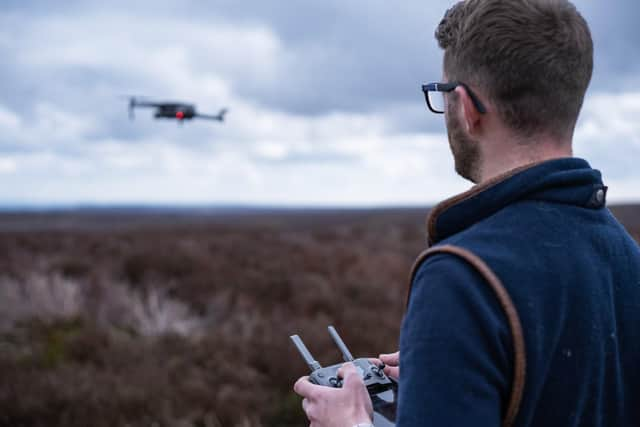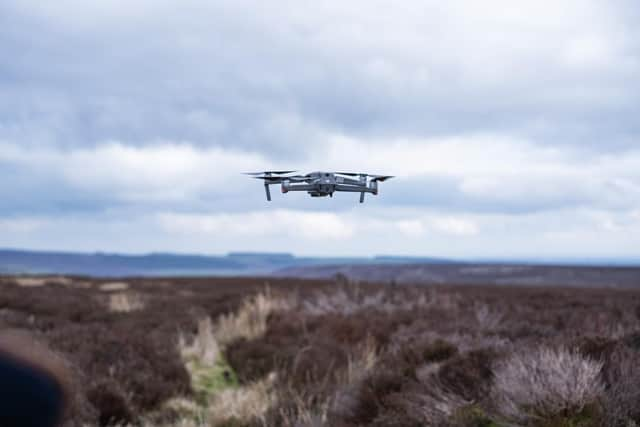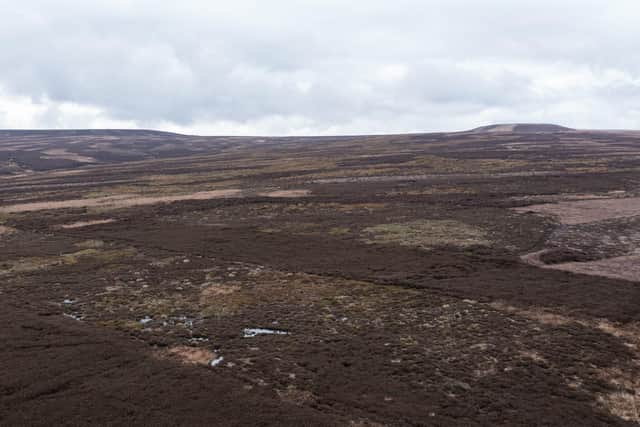Swinton Estate, Moorland Association, Yorkshire Water, Yorkshire Peat Partnership and University of Manchester test whether drones can cut peatland restoration costs
Swinton Estate, a member of the Moorland Association, is taking part in a 10-year study alongside Yorkshire Water, Yorkshire Peat Partnership (YPP) and the University of Manchester to assess the impact of sphagnum mosses on habitat restoration.
The project is a detailed assessment of the reintroduction of sphagnum mosses in peatland habitats, to help prevent carbon emissions and improve water storage in the soil.
Advertisement
Hide AdAdvertisement
Hide AdSphagnum mosses are important peat-forming plants, helping to contribute to long-term carbon sequestration in bog habitats.


The use of drones could be useful because peatland restoration is currently very expensive and labour-intensive.
Rosie Snowden, Yorkshire Wildlife Trust’s peat programme manager, says: “We are already using drones to capture high-resolution topographic and infra-red images. If we can find a way to extract data like sphagnum growth, vegetation structure and species, this could replace ongoing ground-based monitoring by researchers and reduce the cost of such projects across the Great North Bog.”
Mark Cunliffe-Lister of Swinton Estate, chairman of the Moorland Association, adds: “We are keen to play our part in peatland restoration to help improve soil hydrology and to ensure that carbon stays locked up in the ground as much as possible. Reintroducing sphagnum mosses isn’t always successful and ongoing monitoring is very expensive.
Advertisement
Hide AdAdvertisement
Hide Ad"If drones can bring down the cost of peatland restoration that is a win-win for the environment, for land managers and for the public purse.”


The research, which began in August 2017, seeks to understand the impact of reintroducing sphagnum to achieve environmental benefits such as improving water storage in the soil and preventing emissions of greenhouse gases.
The study site is located on Masham-Colsterdale Moor on Swinton Estate, in Nidderdale National Landscape in North Yorkshire.
The land is managed for grouse shooting and is also used for sheep grazing. Sixty plots of ground have been studied in detail by the research team, with varying peat depths of between 30cm and 190cm.
Advertisement
Hide AdAdvertisement
Hide AdA report on the first two years of the project showed that sphagnum cover increased from 10 per cent to 58 per cent on the treated sites. Greenhouse gases, carbon dioxide and methane were also measured as part of the research. The results showed that more carbon was being stored in the soil than emitted though natural processes.


Post-war drainage and air pollution caused by industrial processes have damaged areas of peatland in the north of England, resulting in patches of bare peat which emit carbon dioxide into the atmosphere. Re-vegetating these areas is aimed at helping carbon remain in the ground.
Separately, Swinton Estate has undertaken major peatland restoration works on Colsterdale and Ilton moors, in addition to woodland planting and biodiversity improvements. Drone images are being used to evaluate the outcome of these projects.
This involved revegetating 5.9 hectares of bare peat, to help prevent carbon emissions, cutting existing vegetation across 55 hectares and inoculating with sphagnum species, and blocking 48,480 metres of historic ‘grips’ (drainage channels) to help improve the soil hydrology as well as blocking and reducing sediment flow for 27,948 metres of eroding gullies.
Advertisement
Hide AdAdvertisement
Hide AdThe work on the ground was carried out by Marsden AES with staff from Yorkshire Wildlife Trust provided on behalf of Yorkshire Peat Partnership, along with support from the Swinton Estate management team. All phases were funded by Yorkshire Water.
Nature champion Swinton Estate has previously won a ‘Life on Land’ award from Red List Revival for its conservation work benefiting curlew and hen harrier.
Meanwhile, Moorland Association members are at the forefront of peatland restoration and have already achieved 60 per cent of the work required on their land as part of the government’s commitment to tackling climate change.
Advertisement
Hide AdAdvertisement
Hide AdOver 27,000 hectares of land have been restored and nearly 7,000 kilometres of old agricultural drains blocked, to re-wet the peat, making a significant contribution to England’s carbon sequestration target.
Comment Guidelines
National World encourages reader discussion on our stories. User feedback, insights and back-and-forth exchanges add a rich layer of context to reporting. Please review our Community Guidelines before commenting.